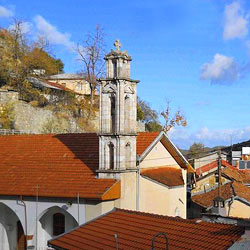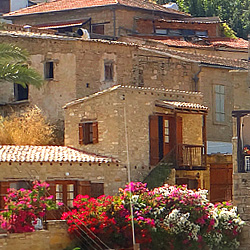
The Museum of Folkloric Art
Galata's Museum of Folkloric Art was established in the summer of 1990 by the -then -Assistant Principal of the School, Mr. Athanasios Papadopoulou.
After a great deal of troubles, rushing around, visiting many villages even up to Pafos, and with the love and contribution of Galata's inhabitants, he managed to create a beautiful Museum that was quite rich in exhibits and one of the first in Cyprus.
The Museum's founder declares:
‹‹My ambition was to salvage -as soon as possible -tools, vessels, garments / attires, furniture, kitchenware, and a collection of items of everyday use that belong to some other eras… I was seeing them thrown away and abandoned in yards, in gardens, and in half-ruined houses, being consumed by the rain, the rust, and the all-subduing Time. I grieved for them, I felt for them, I wanted to protect them, to take care of them, to repair and maintain them, and to place them in a suitable area so that our souls will kneel before them like before holy icons. ››
All of the Museum's items, over five hundred of them, are categorised according to profession. Tools and utilities of the shepherd, the farmer, the silk-breeder, the builder, the butcher, the potter, the lumberjack, the wine-shop owner, the shoemaker, and the carpenter. There's a rich collection of attires, a large variety of kitchenware, and various furnishings that you will feel glad to come to and saunter in.
The openings of Galata's F.A. Museum were conducted by the Minister- at the time -of Education, Mr. Christoforos Christoforou on the 11/11/1990.
A great benefactor of the Museum is the dear departed Michalakis Kythreotis, who "portioned" it with the amount of 2,000 C.P.
The Museum is open in the morning and in the afternoon.
Excerpts from an article of Mr. Lakis Fourouklas in the "Proina Nea" (Morning News) newspaper, 15/9/1990.
……We will now guide you through the Museum's grounds, its entrance by itself predisposing you for what you will see next.
It is a rather small place that -at a first glance -reminds you the traditional Cypriot house with all the elements co-existing in one single room.
The entrance is a traditional, wooden, double door made of pinewood while the roof is made of reeds resting on wooden beams.
The walls are whitewashed and the whole prevailing atmosphere reminds you of the old, village houses that -as they say -are warm in the winter and cool in the summer. Despite the lack of space, Mr. Papadopoulos has managed to classify the various objects, which are contributions of the village's inhabitants, into unities that at the same time bond together with a natural harmony.
So, the tools of the farmer, the shepherd, the builder, the shoemaker, the silk-breeder, and many others, as well as kitchenware co-exist in the same area. In a few words, the museum's exhibits outline the village household from the beginning of the century and onward.
Right as you enter the museum, you will face a "Pouaro" (chest of drawers) that dates back to 1925 and on your left a teacher's desk from 1915. Above them there are paintings and kitchen utensils, some of them dating back to the previous century and reminding us of other times.
On the right there are -craftily placed -traditional Cypriot attires, an old sewing machine, as well as a child's bed made of iron and covered with a white marquisette. On our left there are all sorts of objects that are considered necessary in the traditional Cypriot house such as bread-planks, jugs, wooden shovels, rakes, demijohns for "Zivania" (strong, transparent alcoholic beverage), a loom, and other things.
Of course, tools like the ones of the shoemaker, the plough, the yoke for the horses, the "adhrakti" (kind of distaff with blades), the silk-breeder's apparatus, the spindle, the spinning wheel, and so many others that have marked the life of our country in the beginning of the century.
And all these housed in a very small area.
For all of the museum's exhibits there is a book where both the names of the donators as well as the date that the contributions were made are recorded.




















